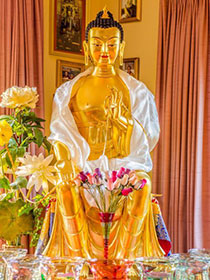- Home
- FPMT Homepage
Foundation for the Preservation of the Mahayana Tradition
The FPMT is an organization devoted to preserving and spreading Mahayana Buddhism worldwide by creating opportunities to listen, reflect, meditate, practice and actualize the unmistaken teachings of the Buddha and based on that experience spreading the Dharma to sentient beings. We provide integrated education through which people’s minds and hearts can be transformed into their highest potential for the benefit of others, inspired by an attitude of universal responsibility and service. We are committed to creating harmonious environments and helping all beings develop their full potential of infinite wisdom and compassion. Our organization is based on the Buddhist tradition of Lama Tsongkhapa of Tibet as taught to us by our founders Lama Thubten Yeshe and Lama Thubten Zopa Rinpoche.
- Willkommen
Die Stiftung zur Erhaltung der Mahayana Tradition (FPMT) ist eine Organisation, die sich weltweit für die Erhaltung und Verbreitung des Mahayana-Buddhismus einsetzt, indem sie Möglichkeiten schafft, den makellosen Lehren des Buddha zuzuhören, über sie zur reflektieren und zu meditieren und auf der Grundlage dieser Erfahrung das Dharma unter den Lebewesen zu verbreiten.
Wir bieten integrierte Schulungswege an, durch denen der Geist und das Herz der Menschen in ihr höchstes Potential verwandelt werden zum Wohl der anderen – inspiriert durch eine Haltung der universellen Verantwortung und dem Wunsch zu dienen. Wir haben uns verpflichtet, harmonische Umgebungen zu schaffen und allen Wesen zu helfen, ihr volles Potenzial unendlicher Weisheit und grenzenlosen Mitgefühls zu verwirklichen.
Unsere Organisation basiert auf der buddhistischen Tradition von Lama Tsongkhapa von Tibet, so wie sie uns von unseren Gründern Lama Thubten Yeshe und Lama Thubten Zopa Rinpoche gelehrt wird.
- Bienvenidos
La Fundación para la preservación de la tradición Mahayana (FPMT) es una organización que se dedica a preservar y difundir el budismo Mahayana en todo el mundo, creando oportunidades para escuchar, reflexionar, meditar, practicar y actualizar las enseñanzas inconfundibles de Buda y en base a esa experiencia difundir el Dharma a los seres.
Proporcionamos una educación integrada a través de la cual las mentes y los corazones de las personas se pueden transformar en su mayor potencial para el beneficio de los demás, inspirados por una actitud de responsabilidad y servicio universales. Estamos comprometidos a crear ambientes armoniosos y ayudar a todos los seres a desarrollar todo su potencial de infinita sabiduría y compasión.
Nuestra organización se basa en la tradición budista de Lama Tsongkhapa del Tíbet como nos lo enseñaron nuestros fundadores Lama Thubten Yeshe y Lama Zopa Rinpoche.
A continuación puede ver una lista de los centros y sus páginas web en su lengua preferida.
- Bienvenue
L’organisation de la FPMT a pour vocation la préservation et la diffusion du bouddhisme du mahayana dans le monde entier. Elle offre l’opportunité d’écouter, de réfléchir, de méditer, de pratiquer et de réaliser les enseignements excellents du Bouddha, pour ensuite transmettre le Dharma à tous les êtres. Nous proposons une formation intégrée grâce à laquelle le cœur et l’esprit de chacun peuvent accomplir leur potentiel le plus élevé pour le bien d’autrui, inspirés par le sens du service et une responsabilité universelle. Nous nous engageons à créer un environnement harmonieux et à aider tous les êtres à épanouir leur potentiel illimité de compassion et de sagesse. Notre organisation s’appuie sur la tradition guéloukpa de Lama Tsongkhapa du Tibet, telle qu’elle a été enseignée par nos fondateurs Lama Thoubtèn Yéshé et Lama Zopa Rinpoché.
Visitez le site de notre Editions Mahayana pour les traductions, conseils et nouvelles du Bureau international en français.
Voici une liste de centres et de leurs sites dans votre langue préférée
- Benvenuto
L’FPMT è un organizzazione il cui scopo è preservare e diffondere il Buddhismo Mahayana nel mondo, creando occasioni di ascolto, riflessione, meditazione e pratica dei perfetti insegnamenti del Buddha, al fine di attualizzare e diffondere il Dharma fra tutti gli esseri senzienti.
Offriamo un’educazione integrata, che può trasformare la mente e i cuori delle persone nel loro massimo potenziale, per il beneficio di tutti gli esseri, ispirati da un’attitudine di responsabilità universale e di servizio.
Il nostro obiettivo è quello di creare contesti armoniosi e aiutare tutti gli esseri a sviluppare in modo completo le proprie potenzialità di infinita saggezza e compassione.
La nostra organizzazione si basa sulla tradizione buddhista di Lama Tsongkhapa del Tibet, così come ci è stata insegnata dai nostri fondatori Lama Thubten Yeshe e Lama Zopa Rinpoche.
Di seguito potete trovare un elenco dei centri e dei loro siti nella lingua da voi prescelta.
- 欢迎 / 歡迎
简体中文
“护持大乘法脉基金会”( 英文简称:FPMT。全名:Foundation for the Preservation of the Mahayana Tradition) 是一个致力于护持和弘扬大乘佛法的国际佛教组织。我们提供听闻,思维,禅修,修行和实证佛陀无误教法的机会,以便让一切众生都能够享受佛法的指引和滋润。
我们全力创造和谐融洽的环境, 为人们提供解行并重的完整佛法教育,以便启发内在的环宇悲心及责任心,并开发内心所蕴藏的巨大潜能 — 无限的智慧与悲心 — 以便利益和服务一切有情。
FPMT的创办人是图腾耶喜喇嘛和喇嘛梭巴仁波切。我们所修习的是由两位上师所教导的,西藏喀巴大师的佛法传承。
繁體中文
護持大乘法脈基金會”( 英文簡稱:FPMT。全名:Found
ation for the Preservation of the Mahayana Tradition ) 是一個致力於護持和弘揚大乘佛法的國際佛教組織。我們提供聽聞, 思維,禪修,修行和實證佛陀無誤教法的機會,以便讓一切眾生都能 夠享受佛法的指引和滋潤。 我們全力創造和諧融洽的環境,
為人們提供解行並重的完整佛法教育,以便啟發內在的環宇悲心及責 任心,並開發內心所蘊藏的巨大潛能 — 無限的智慧與悲心 – – 以便利益和服務一切有情。 FPMT的創辦人是圖騰耶喜喇嘛和喇嘛梭巴仁波切。
我們所修習的是由兩位上師所教導的,西藏喀巴大師的佛法傳承。 察看道场信息:
- FPMT Homepage
- News/Media
-
- Study & Practice
-
-
- About FPMT Education Services
- Latest News
- Programs
- New to Buddhism?
- Buddhist Mind Science: Activating Your Potential
- Heart Advice for Death and Dying
- Discovering Buddhism
- Living in the Path
- Exploring Buddhism
- FPMT Basic Program
- FPMT Masters Program
- FPMT In-Depth Meditation Training
- Maitripa College
- Lotsawa Rinchen Zangpo Translator Program
- Universal Education for Compassion & Wisdom
- Online Learning Center
-
- Prayers & Practice Materials
- Overview of Prayers & Practices
- Full Catalogue of Prayers & Practice Materials
- Explore Popular Topics
- Benefiting Animals
- Chenrezig Resources
- Death & Dying Resources
- Lama Chopa (Guru Puja)
- Lama Zopa Rinpoche: Compendium of Precious Instructions
- Lama Zopa Rinpoche: Life Practice Advice
- Lama Zopa Rinpoche Practice Series
- Lamrim Resources
- Mantras
- Prayer Book Updates
- Purification Practices
- Sutras
- Thought Transformation (Lojong)
- Audio Materials
- Dharma Dates - Tibetan Calendar
- Translation Services
- Publishing Services
- Ways to Offer Support
- Prayers & Practice Materials
-
- Teachings and Advice
- Find Teachings and Advice
- Lama Zopa Rinpoche Advice Page
- Lama Zopa Rinpoche: Compendium of Precious Instructions
- Lama Zopa Rinpoche Video Teachings
- ༧སྐྱབས་རྗེ་བཟོད་པ་རིན་པོ་ཆེ་མཆོག་ནས་སྩལ་བའི་བཀའ་སློབ་བརྙན་འཕྲིན།
- Podcasts
- Lama Yeshe Wisdom Archive
- Buddhism FAQ
- Dharma for Young People
- Resources on Holy Objects
- Teachings and Advice
-
-
*If a menu item has a submenu clicking once will expand the menu clicking twice will open the page.
-
-
- Centers
-
- Teachers
-
- Projects
-
-
-
-
*If a menu item has a submenu clicking once will expand the menu clicking twice will open the page.
-
-
- FPMT
-
- Shop
-
-
-
The Foundation Store is FPMT’s online shop and features a vast selection of Buddhist study and practice materials written or recommended by our lineage gurus. These items include homestudy programs, prayers and practices in PDF or eBook format, materials for children, and other resources to support practitioners.
Items displayed in the shop are made available for Dharma practice and educational purposes, and never for the purpose of profiting from their sale. Please read FPMT Foundation Store Policy Regarding Dharma Items for more information.
-
-
8
How Do Holy Objects Work?
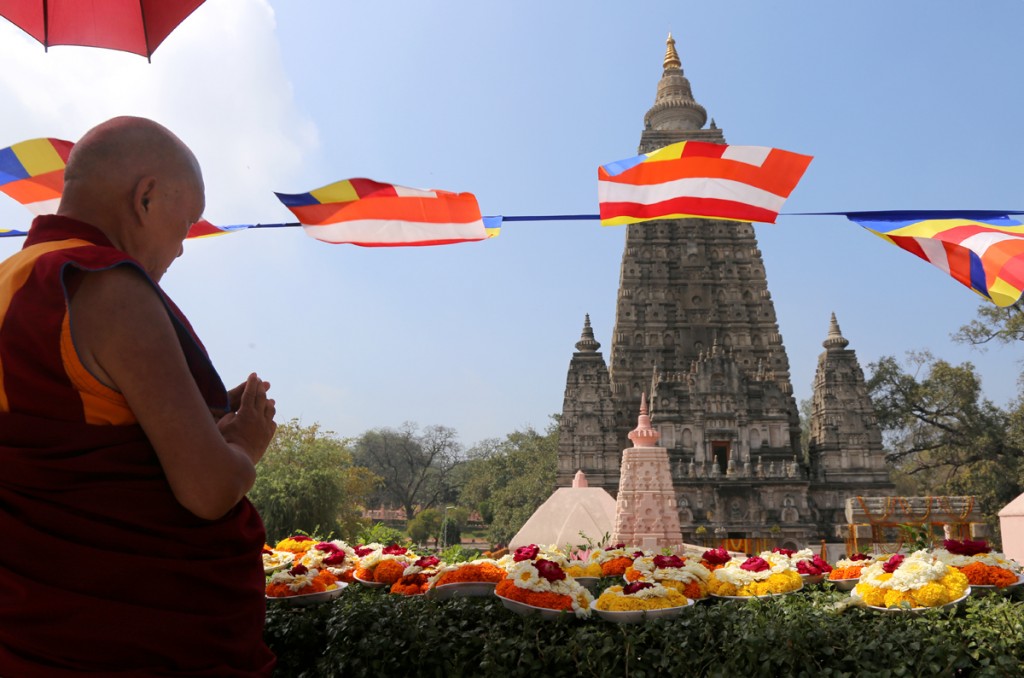
Lama Zopa Rinpoche making offerings to the Mahabodhi Stupa, Bodhgaya, India. Photo by Ven. Thubten Kunsang.
By Ven. Tenzin Legtsok
Recently, a Dharma friend asked me a question which comes up often in relation to holy objects such as stupas, sutras, and mantras. “So, there’s a story in the lam-rim about a fly unintentionally going around a stupa and as a result having the root of virtue required to take ordination as a novice monk in a future lifetime,” he began. “How could it be that virtue was created in that fly’s mental continuum when the fly had no positive motivation?” he asked. “And if that root of virtue arose in the fly’s mind solely due to the power of the stupa, doesn’t that mean the stupa’s power to benefit sentient beings exists from its own side and so is inherently existent?”
The story, told in Liberation in the Palm of Your Hand,1 is about an old man named Shrijata who wanted to leave his home and take ordination. Venerable Shariputra refused to give Shrijata novice vows, explaining that he didn’t have the roots of virtue to be able to keep ordination. Shrijata was utterly disappointed. Shakyamuni Buddha saw the situation through his clairvoyance, appeared to Shrijata and told him that he does have the roots of virtue to take ordination, but that this virtue is so subtle that Shariputra could not see it. This virtue, the Buddha said, was created in Shrijata’s past life when as a fly – following a cartload of dung – he unknowingly circumambulated a stupa.
According to the Buddhist philosophy of the Middle Way clearly expressed by Nagarjuna, Chandrakirti and Lama Tsongkhapa, it’s argued that nothing exists inherently or totally independent of other things, from its own side. Even if the virtuous imprint that arose in that fly’s mental continuum as a result of going around the stupa was not dependent whatsoever on the fly having a virtuous intention or positive motivation, still the fly had to go around the stupa for that imprint to be produced. That particular root of virtue couldn’t have arisen in the fly’s continuum if it hadn’t gone around the stupa.
Lama Tsongkhapa wrote in The Great Treatise on the Stages of the Path to Enlightenment (Lamrim Chenmo), “Those who enjoy the fruits of the innumerable collections amassed by the Teacher need not have accumulated all of the causes of these effects, but they do need to accumulate a portion.”2 So, it’s argued that the fly created a portion of the cause to enjoy the results of the merit collected by past buddhas simply by going around the stupa. Thus, the resultant virtuous imprint that arose in the fly’s continuum was a complex dependent arising connected to the activity of past holy beings and did not arise solely because of the physical stupa, although it did play a part. Even the physical stupa itself is not inherently existent because it exists in dependence on parts, such as its four sides; in dependence on causes and conditions, such as the people who built the stupa and the material it was made from; and in dependence on mental imputation, the label “stupa” being applied appropriately to the base for this label.
But a question remains: how does an inanimate object – no matter how sacred – affect sentient beings regardless of their motivation? This is not so easy of a question to answer. If you’re in doubt that the Buddha taught this, the idea is reiterated in the King of Concentration Sutra, where it says that even looking upon a drawing of a stupa with a mind of anger creates the cause to see millions of buddhas in the future. Similar statements are made in other sutras – such as the Sutra of Golden Light or the Sanghata Sutra – about how hearing merely a few lines from these sutras purifies negative karma collected over eons and helps a practitioner accumulate inconceivable amounts of merit. Lama Zopa Rinpoche has explained that such effects are due to the power of prayer. “It’s like mantra,” Lama Zopa Rinpoche said. “A mantra has power because a buddha blesses it to have power. A mantra is powerful because a buddha makes it powerful. This [ability], the power of prayer, is one of a buddha’s 10 powers.”3
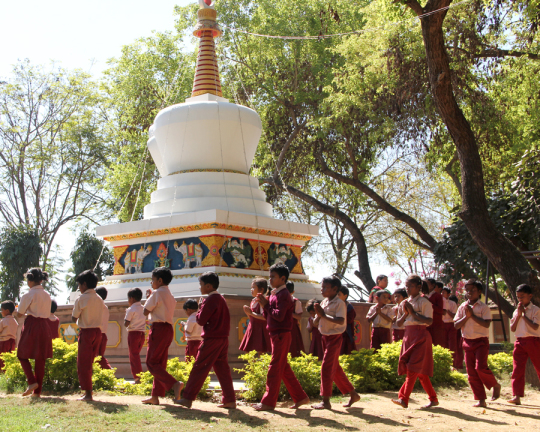
Students circumambulating the stupa at Maitreya School, Root Institute, Bodhgaya, India, March 2015. Photo by Ven. Roger Kunsang.
The power of prayer or aspiration (mönlam gyi wang in Tibetan) is one of many qualities of the wisdom truth body (jñana-dharmakaya) enumerated in chapter 8 of Maitreya’s Ornament of Clear Realization (Abhisamayalamkara). Lama Tsongkhapa describes this quality as follows, “Because they accomplish just as they wish, they have power over prayers included.”4 In short, this means that buddhas have achieved the power to accomplish whatever prayers they make. Lama Tsongkhapa adds that this ability is the result of joyous effort – the fourth of the six perfections – because in the past as bodhisattvas they never stopped striving for the welfare of sentient beings.
One might counter argue, “How could buddhas have the power to accomplish whatever they pray for? They pray for all sentient being to be free from suffering yet countless sentient beings still suffer.” The buddhas’ having achieved the power of prayer is similar to their having achieved the perfection of generosity. That a buddha has completed the perfection of generosity doesn’t mean that they have eliminated all poverty in the world, but instead, that they have perfected the attitude wishing to give whatever they possess for the welfare of others.5 Similarly, achieving power over prayer does not mean that a buddha’s prayers are all immediately fulfilled exactly in accordance with their aspirations, but that from the buddha’s side there is nothing more that could be done to fulfill their prayers. All the incredibly vast oceans of merit that a buddha has accumulated previously as a bodhisattva on the path and as a fully enlightened being has been dedicated toward the fulfillment of their prayers and continually functions to fulfill these intentions. What remains undone is only from the side of sentient beings. Shantideva made a prayer in A Guide to the Bodhisattva’s Way of Life:
If in those who encounter me
A faithful or an angry thought arises,
May that eternally be the source
For fulfilling all their wishes.6
Bodhisattvas create unimaginably huge collections of merit and wisdom on the path to enlightenment through their practice of great compassion, bodhichitta and the six perfections. By dedicating all of this positive energy toward fulfilling the welfare of sentient beings, they make it possible for us to enjoy a portion of the fruits of their virtue, what Lama Tsongkhapa’s quote above was about. Thus, the force of bodhichitta, the two collections of merit and wisdom, prayers from the side of enlightened beings, and from the side of ordinary sentient beings like us, the condition of encountering sacred objects – even without a virtuous motivation – together create the possibility for us to easily accumulate virtue, purify negative karma and plant the seeds for liberation and enlightenment. This is one way that stupas, mantras and other holy objects are imbued with power, which is the common answer to the questions about the unintentionally virtuous fly.
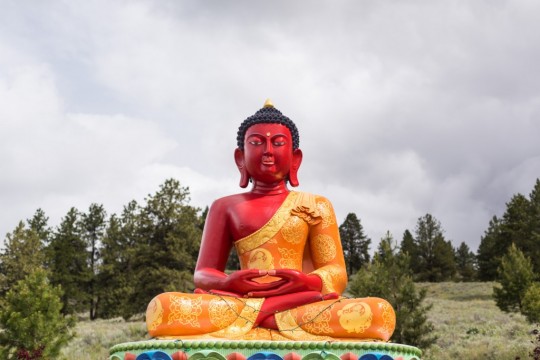
Amitabha Buddha statue at Buddha Amitabha Pure Land, Washington, US, June 2015. Photo by Chris Majors.
This ability that stupas, statues and scriptures have to almost passively plant seeds of virtue and enlightenment in the minds of sentient beings makes it obvious what an incredibly skillful means it is to build such holy objects, especially when we consider how hard it is to create causes for liberation from samsara and complete buddhahood. In his discussion of the second noble truth about the origins of suffering, Lama Tsongkhapa makes the very sobering point that without actual renunciation, bodhichitta, or wisdom realizing emptiness, except by the power of exceptional objects in relation to which we create actions, all our virtuous actions contribute to further wandering in cyclic existence under the control of karma. Lama Tsongkhapa says:
… you might not have acquired, through extensive meditative analysis of the faults of cyclic existence, the remedy that eradicates the craving for the wonders of cyclic existence. Also you might not have used discerning wisdom to properly analyze the meaning of selflessness, and might not have become familiar with the two spirits of enlightenment [conventional and ultimate]. Under such circumstances, your virtuous activities – with some exceptions on account of the field’s power – would constitute typical origins of suffering, and hence would fuel the process of cyclic existence.7
For most sentient beings, it is rare to have a truly virtuous thought arise and actual renunciation, bodhichitta and the wisdom realizing emptiness are unheard of. Even among those fortunate enough to aspire to these attitudes, most do not have a clear idea what they are and exactly how to cultivate them, or, although intellectually understanding them, do not actually generate these realizations in their mindstreams. In short, for most of us it is incredibly difficult to generate an actual cause for liberation and enlightenment. The big exception is “on account of the field’s power,” which is to say that in relation to exceptional objects such as the guru, Buddha, Dharma, Sangha, and the holy objects representing these, we can easily create causes for nirvana and the state of omniscience. If by just seeing such objects with a mind of anger plants the seeds for all the realizations on the path to enlightenment, as indicated in the King of Concentration Sutra, then there is no need to mention the far reaching benefits of viewing such objects with a mind of faith, making offerings, constructing and paying homage to these objects in various ways. Through the power of prayer of extraordinary beings, holy objects provide unique opportunities for sentient beings of all levels of intelligence, from the tiniest insects to the most brilliant humans and gods, to easily create causes for liberation and enlightenment and enjoy a share of the positive effects of the buddhas’ two collections of merit and wisdom.
Two objections can arise from our common understanding of the general characteristics of karma and they are important to consider. The first is how can a negative attitude such as anger or craving produce a happy result such as seeing millions of buddhas or taking ordination if karma is certain, in the sense that every experience of pleasure must have arisen from a previous positive karma that is its cause, and every experience of suffering must have arisen from non-virtue. The second is how can we experience the results of positive karmic actions created by others such as buddhas and bodhisattvas if we do not experience the effects of karmic actions we did not commit.
In general, one karmic action can be very complex, arising from a collection of positive and negative causes and producing a variety of results, some pleasant and others unpleasant. For instance, when someone gets angry and insults us and we patiently respond with genuine kindness and concern, we create a positive karma. Although the karmic result of this will be a pleasant experience, one cause of that experience is the anger of the person who insulted us. In the case of someone scowling at an image of a buddha with anger, they will definitely suffer as a result of this action because it is motivated by an afflictive emotion. However, due to the power of the object, an incredibly virtuous object in this case, they will also experience a positive result of that action. The negative result arises primarily due to their negative attitude, whereas the positive result arises primarily due to the power of the particular object, such as a buddha image that is able to produce a positive result for the reasons given above.
In response to the second objection, it’s true that we don’t experience the results of karma created by others with whom we have no relationship whatsoever. However, in some cases, we can experience the results of karma created by others when we form a karmic link with them. For example, when a group of people collectively do an action, like saving the lives of 100 fish, each member of the group accumulates the karma created by the group. In the case of the lucky fly discussed above, it created a karmic link with enlightened beings by going around the stupa. That small action enabled the fly to experience a portion of the positive results arising from the buddhas’ infinite collection of merit and wisdom. In short, the help enlightened beings extend to us is like a hand reaching down to help us climb out of a hole: if we don’t extend a hand up for it to grab onto, we can’t benefit from it.
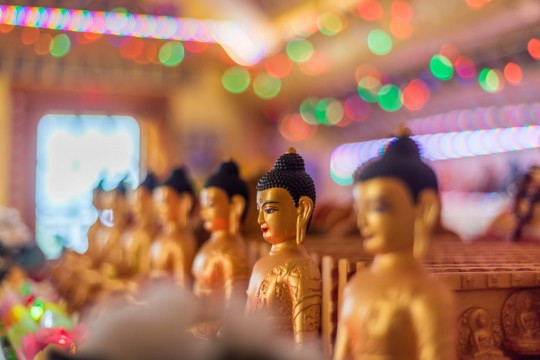
Countless statues, tsa-tsa, sacred images and offerings fill Lama Zopa Rinpoche’s room at Buddha Amitabha Pure Land, Washington, US, June 2015. Photo by Chris Majors.
The Buddha famously said to analyze his teachings like a goldsmith analyzes gold:
Like gold [that is acquired] upon being scorched, cut, and rubbed,
My word is to be adopted by monastics and scholars
Upon being analyzed well,
Not out of respect [for me].8
We should not throw skepticism to the wind and blindly believe whatever we see in the Buddha’s teachings. That wouldn’t provide a firm foundation for our spiritual development. However, we also need to avoid scornfully dismissing the possibility that sacred objects and beings can have an enlightening influence on us in ways we cannot readily explain. This could close avenues of possible benefit to us which at the time we can’t fully appreciate and lead us to create the heavy negative karma of abandoning the Buddha’s teachings.
The subtle workings of karma are among the most difficult topics in which to gain conviction and because they are considered “very hidden phenomena,” they are traditionally “proven” by appealing to the validity of the Buddha and his teachings. In Buddhist works on valid cognition and logic, the integrity of Buddha as a teacher is established by showing that his teachings on the four noble truths, and especially on emptiness, are true. Generating faith in the Buddha and his teachings, especially on karma, needs to involve not just our intellect, but more importantly, our heart through personal experimentation with the practices taught, which can be a lifelong endeavor much like developing a deep trusting relationship with a spouse or friend. To develop conviction in the power of holy objects, mantras and sutras, it helps to have a reasonable way to conceive of how they can affect us and why this is important. For this purpose, I have tried to present a few supporting arguments and scriptural citations to consider. In the end, though, the measure of whether a set of practices are beneficial to us or not must be our own experience.
In finding our own way to the mountaintop, it would be foolish not to consult the accounts of past masters who’ve gone before such as Shakyamuni Buddha, the ancient Indian pandits of Nalanda and the sages of Tibet by extensively reading their works. As well, it is invaluable to make contact with living teachers who fully embody the Buddha’s teachings, listen to their message and seek their advice. Then while engaging in practices according to their instructions, we monitor whether the transformation in our own minds is for better or worse. Where we see benefit, we delve further and find ourselves discovering possibilities to create inner sources of well-being we had not known before.
Ven. Tenzin Legtsok is currently in his 12th year of the Geshe Studies program at Sera Je Monastic University. He has been ordained as a Buddhist monk since 2001. Born in Virginia, US, in 1973, he obtained a Bachelor of Arts from Kenyon College in 1995. The question of what makes for the most happy and meaningful life, which compelled him to major in philosophy during college, gradually lead to his study of meditation and philosophy with teachers among the exiled Tibetan communities in India and Nepal from 1999 until the present. For the past 10 years he has tried to make basic Buddhist teachings accessible to various audiences in India and the US.
1. Pabongka Rinpoche, translated by Michael Richards (Wisdom, Boston 1991) p. 440.
2. Tsong-kha-pa, The Great Treatise on the Stages of the Path to Enlightenment Vol. 1, p. 214.
3. From a conversation with the author in Bangalore, India, 2008.
4. Tsongkhapa, legs bshad rin po che gser gyi phreng ba bzhugs so (Sera Jey Monastic University, 2001). This line was translated by the author although the entire work translated into English by Garath Sparham is published by Jain Publications: Golden Garland of Eloquence, and the line cited here is in Vol. 4, p. 180-1
5. See Tsong-kha-pa, The Great Treatise on the Stages of the Path to Enlightenment Vol. 2, edited by Joshua Cutler (Snow Lion, Boston 2004) pp. 114-5.
6. Shantideva, A Guide to the Bodhisattva’s Way of Life, trans. By Stephen Batchelor (Library of Tibetan Works and Archives, Dharamsala 1979) Chp. 3, vs. 16.
7. Tsong-kha-pa, The Great Treatise on the Stages of the Path to Enlightenment Vol.1, p. 305-6. Tsongkhapa’s statement here is based on a passage by Arya Asanga from the Compendium of Determinations.
8. Cited in Tshongkhapa’s, Treatise Differentiating Interpretable and Definitive Meanings; The Essence of Elloquence, translated by Jeffrey Hopkins in Emptiness in the Mind Only School (University of California Press, London, 1999) p. 71.
- Tagged: holy objects, in-depth stories, online feature, stupas
- 1
- Home
- News/Media
- Study & Practice
- About FPMT Education Services
- Latest News
- Programs
- New to Buddhism?
- Buddhist Mind Science: Activating Your Potential
- Heart Advice for Death and Dying
- Discovering Buddhism
- Living in the Path
- Exploring Buddhism
- FPMT Basic Program
- FPMT Masters Program
- FPMT In-Depth Meditation Training
- Maitripa College
- Lotsawa Rinchen Zangpo Translator Program
- Universal Education for Compassion & Wisdom
- Online Learning Center
- Prayers & Practice Materials
- Overview of Prayers & Practices
- Full Catalogue of Prayers & Practice Materials
- Explore Popular Topics
- Benefiting Animals
- Chenrezig Resources
- Death & Dying Resources
- Lama Chopa (Guru Puja)
- Lama Zopa Rinpoche: Compendium of Precious Instructions
- Lama Zopa Rinpoche: Life Practice Advice
- Lama Zopa Rinpoche Practice Series
- Lamrim Resources
- Mantras
- Prayer Book Updates
- Purification Practices
- Sutras
- Thought Transformation (Lojong)
- Audio Materials
- Dharma Dates – Tibetan Calendar
- Translation Services
- Publishing Services
- Teachings and Advice
- Find Teachings and Advice
- Lama Zopa Rinpoche Advice Page
- Lama Zopa Rinpoche: Compendium of Precious Instructions
- Lama Zopa Rinpoche Video Teachings
- ༧སྐྱབས་རྗེ་བཟོད་པ་རིན་པོ་ཆེ་མཆོག་ནས་སྩལ་བའི་བཀའ་སློབ་བརྙན་འཕྲིན།
- Podcasts
- Lama Yeshe Wisdom Archive
- Buddhism FAQ
- Dharma for Young People
- Resources on Holy Objects
- Ways to Offer Support
- Centers
- Affiliates Area
- Teachers
- Projects
- Charitable Projects
- Make a Donation
- Applying for Grants
- News about Projects
- Other Projects within FPMT
- Support International Office
- Projects Photo Galleries
- Give Where Most Needed
- FPMT
- Shop
Translate*
*powered by Google TranslateTranslation of pages on fpmt.org is performed by Google Translate, a third party service which FPMT has no control over. The service provides automated computer translations that are only an approximation of the websites' original content. The translations should not be considered exact and only used as a rough guide.The sun of real happiness shines in your life when you start to cherish others.







